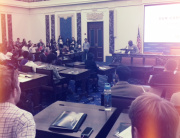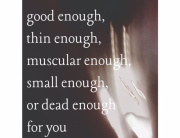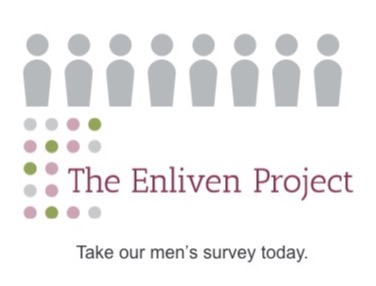Particularly with sexual violence, the shame and stigma associated with the issue is so significant that it’s hard to count what isn’t being reported. Think about erectile dysfunction. Ten years ago, it would have been impossible to know how many people were suffering from erectile dysfunction. Now that there is a cure, a successful pathway to recovery, people are comfortable talking about it to their doctors and we have much more accurate figures.
The purpose of the illustration – and of The Enliven Project – is to provoke new kinds of conversations about sexual violence. We hope that you have been inspired to have deeper conversations about sexual violence because of what you have seen and read here.
For those of you who have asked, here is the background on the stats we used:
- Some reports suggest that only 5-25% of rapes are reported to authorities. Other suggest that close to half are reported. We assumed 10%, which is dramatic, but possible.
- Of the rapes that are reported, approximately 9 are prosecuted.
- Of the prosecuted, 5 result in felony convictions. This is across the board for all felony prosecutions, not just rape.
- Assuming that 2% of reported rapes are false and a 10% reporting rate, the graphic assumes that 2 of 1000 rapes are falsely reported (assuming a rape can’t be falsely reported unless it’s reported in the first place)
If you have other stats you would like to share, please leave them in comments. Thank you!






Howdy! This article could not be written any better! Looking at this post reminds me of my previous roommate! He constantly kept preaching about this. I’ll send this information to him. Fairly certain he’s going to have a good read. Thanks for sharing! kaggfbbkdfac
[…] infographic that purports to break down disturbing rape statistics went viral on Monday, but not everyone is […]
[…] Det innebär att två tredjedelar av de ljusbruna gubbarna ryker direkt. Att kalla det för ”sanningen om falska anklagelser” påskiner ju att man har något mer på fötterna. Efter kritik för bristande källhänvisning la författaren upp en sida med några länkar: […]
[…] But wait. […]
[…] Beaulieu, trying to justify the infographic, assumes that only 2% of rape reports are false. This is, as it turns out, not only her assertion; […]
[…] combing through Enliven’s listed sources for the disputed infographic, I realized that Enliven’s graphic is partly a re-hashing of […]
[…] National Crime Victimization Survey: 2006-2010 and FBI reports.” Sounds good. But wait: “…This infographic…combines data from several sources, both domestic and […]
[…] National Crime Victimization Survey: 2006-2010 and FBI reports.” Sounds good. But wait: “…This infographic…combines data from several sources, both domestic and […]
As someone who has been falsely accused of rape, the way the statistic on false allegations has been used here is disingenuous and distressing. What we need is clear representation of the facts to the extent that they are known. Not a manipulation of them for effect - this risks a breakdown of communication.
Being FALSELY accused of rape is a massive psychological and material assault. It is a trauma experience in its own right. It can cause long-term depression, huge and prolonged stress, shame and humiliation, panic and other anxiety problems, paranoia, family and marital problems, and loss of job and career. After it is over there is still the fear that it may happen again (characteristic of all trauma experiences). It knocks your life into a crazy place. Its complicated by the horror, bewilderment and anger at the injustice of it all. You are treated as a perpetrator until exonerated. This is more horrible than you can imagine - and it is possible that you never get to feel exonerated because (a) if the case does not come to court you may never be fully exonerated (and the false complainant receives no sanction - they are an abuser who has got away with it), and (b) If it does go to court and there is an acquittal, are there not many who think “no smoke without a fire”? And by then, a terrible amount of damage has already been done to the victim already.
The complex reality that needs to be negotiated is that:
1. Many men are sexually aggressive and sexual trauma is usually very destructive
2. Significant - and probably increasing - numbers of women do make false allegations for a variety of reasons and this is usually very destructive (not only to the victim but harmful too to the actual victims of sexual violence)
Keep up the great piece of work, I read few posts on this web site and I conceive that your blog is really interesting and has lots of wonderful info.
[…] the total number of rapes come from, here? The Enliven Project, which created the graphic, explains here that estimates of the ratio of reported rapes to total rapes ranges from 5% to 50%, depending on […]
I want to be counted. I was raped at the age of seventeen almost twenty years ago. Is there a list that we could join that would allow those of us who are willing to come forward in an aid to provide more accurate data? I have written a blog post about this called “Rape? Count Me In” on my blog at http://www.elizabethmckeeverunfiltered.com.
Regarding the 2% false reporting rate: even if 2% is accurate, it makes absolutely no sense for the graphic maker to discount this by the overall reporting rate as they did (resulting in the assertion of 2 false reports per 1000 rapes, or .02%). The implication of discounting the false reporting rate by the overall reporting rate is that 90% of false reports are not reported, which is absurd.
Of course, if you remove this adjustment there would then be more “falsely accused” silhouettes than “jailed” silhouettes, which is something of a problem for the narrative.
I saw this on Tumblr and reblogged it yesterday. Today, i saw this follow up from some reprehensible people at Reddit: http://img69.imageshack.us/img69/5836/24675342.gif
The comments are also pretty eye-opening. http://www.reddit.com/r/MensRights/comments/166d02/the_truth_about_false_rape_accusation/
Hi Sarah,
I would like to know what sofware you’ use to chart your data.
Thanks.
With respect to the data junkies, I think you’re missing the point. Conversations need to take place. Survivors need resources. We need to seriously think about how atrocious it is that our culture allows and even encourages rape. This graphic is moving the issue. Instead of just posting disparaging comments, I encourage you to generate additional graphics that employ the methods of data collection you’re mentioning and help empower survivors. If you can do it better, please do. It will add to the dialogue. More information is powerful while nitpicking is only derailing the critical conversation.
The only thing this graphic is doing is further solidifying the fact that feminist organizations will warp whatever data they need to get the results they want.
Yeah, you’re moving the conversation forward, in the direction of the mens rights movement, I hope you know that.
[…] the Enliven Project state “one of the key challenges about sexual assault statistics is that it’s nearly […]
hm, i have some questions.
“2 of 1000 rapes are falsely reported” - if it is falsely reported it is not a rape, right? do you want to say the ratio of falsely reported rapes and actual rapes is 2:1000? this ration holds for falsely reported rapes and reported rapes or falsely reported rapes and estimated number of rapes (not necessarily reported)? this is very confusing, please elaborate.
“Of the rapes that are reported, approximately 9 are prosecuted. Of the prosecuted, 5 result in felony convictions.” 9 what? %? again, 5% you mean?
more accuracy please.
Exactly how did you come up with assuming the 2% number for falsely reported rapes and the 10% reporting rape? The 10% reporting rate is on the low end of your own cited spectrum and if the 2% false claims number is from those reported then it must be view with the same skepticism as all the other reported information.
Interesting. Your data indicates that nine rapes are prosecuted, and five felony convictions occur (not just from the nine rape cases, but across all cases). Is this dataset for the entire United States over the course of a year?
I’m going to quote PierceHarlan because I think he said it best:
Isn’t it wonderful that the author of this graph is able to do what no rational and honest person is able to do: divine that all of these persons who weren’t brought to justice were, in fact, rapists. You see, the accusation becomes its own conviction. Why bother with trials when you can have slick “rapist” graphs instead? I find this graph not just dishonest but repulsive. It is an affront to the community of the wrongly accused and is akin to holding reality up to a funhouse mirror: the image it creates is so misshapen, that one must look elsewhere to find the truth. The fact is, the vast majority of rape claims fall into a gray area where no one can say with certainty whether the claim amounted to an actual rape. Every serious study — every single one — leads to that conclusion. The dishonesty at work here is breathtaking.
Combining Data from multiple places is bad practice. You are combining the UK and the US data a decade apart. Event with the best intentions, your numbers will be statistically meaningless.
For example, looking at the UK report you cited, it says “Across all forces nationally, detection rates varied from 22.2 to 93.4 percent in 2001/02 and from 7.0 to 60.4 per cent in 2004/05”.
So out of 22-93 & 7-60, you pulled 10%?!?
Then from the same report “From the 2000 sample, 22.7 per cent (112 reports) were classified as ‘no
crime’; from 2005, the figure was 23.8 per cent (179 reports)” … “False allegations accounted for 36.6 per cent of all recorded ‘no crimes’ in the 2000 sample and 43.0 per cent in 2005. However, if all ‘no crimes’ falling under the ‘verifiable information’ criterion are perceived to be false, these figures rise to 85.7 and 90.5 per cent respectively”
That creates a range of ~10%->39% (22.7*.43)->(43*.905). But you use 2%.
Do you realize that by using the *SAME* sources, you can create a picture showing out of 100, 39 false reports and 57 arrests, leaving only 4 rapists?
I think the info graph makes a good point but I don’t understand why you use 2% for the number of false accusations. The paper you cite shows a range from 2% to 8%. Shouldn’t you use a number in the middle of that range?
@EvilPundit seriously??? Even reading all of the data in a way most favorable to allegedly falsely accused individuals, there’s no rape “hysteria” — rather, there’s a serious problem of rape and sexual assault.
One of the things I really dislike about the debate over false accusations is that preventing false convictions gets inevitably put in opposition to punishing rapists. We can and should have our cake and eat it too. No one in their right mind wants rapists to escape justice *or* innocent men and women to go to jail.
Sarah…I’m wondering if you’d be willing to address one implication of your claim about the 2% false accusation rate vs. the Felony Defendant stats you link to from the BJS.
You imply that you have generalized the stats on that report of all felonies to rape prosecutions as well. I don’t know if that’s accurate, but lets assume that it is.
According to that PDF, 24 percent of cases that are referred to felony prosecution in those counties are either a) dismissed or b) result in an acquittal.
Doing the math on the NPCA page you linked to with stats from 1997 on odds of a report leading to an arrest an arrest leading to prosecution, for 1997 there were about 96,000 rapes reported which would have resulted in 39,000 prosecutions. Of those, 9,360 would have been dismissed or resulted in an acquittal or 9.75%.
It seems to me the only way the 2% rate could be maintained is if the vast majority of everyone who has a rape charge dismissed or is acquitted is, in fact, guilty of the crime they were charged with (and that’s assuming on the other side that every convicted defendant is actually guilty despite quite a bit of evidence to the contrary).
Finally, just a general criticism. I think the reference to rapes of false reports in step 4 is a bit odd. Typically what those stats measure and the linked article seems to support is the percentage of reports deemed unfounded by law enforcement before deciding whether or not to arrest an individual or refer him or her for prosecution. Importing that percentage then at the end of your calculation when you’re in the prosecution phase is a move that doesn’t make a lot of sense to me. Those 2 to 8 percent — depending on the study — of unfounded (which is not the same as false) reports are weeded out in step 2 of your calculation in that they aren’t prosecuted at all.
[…] (9 - not percent, but a number), and of the 9, only 5 become felony convictions. (See Enliven Project) And yet. . […]
I’d like to share the figure of 8 percent for false reports. It comes from the same place you get 2 percent: the claim, in the document to which you link, that methodologically rigorous studies find 2-8 percent of reports are false. I expect the real figure is even higher, given that document’s clear ideological bias — but presumably there’s at least some basis for the document’s claim, whereas there’s no basis for choosing the low end.
Also, the graphic says that 2 out of 1,000 rapists are falsely accused. I suppose some meaning could be found in that, but it is basically nonsense. The concern about false accusation is that INNOCENT MEN, not rapists, are falsely accused. Unless for some reason you wish to call attention to the number of actual rapists who are also accused of rapes they didn’t commit, the false accusations should be taken out of the block of rapists.
And really, there is a deeper mathematical problem: What does your denominator, the 1,000, represent? Is it *actual rapes*? If so, then the false accusations are not part of that pool. Is it *reported rapes*? If so, then all those unreported cases aren’t part of that pool. Is it *instances of someone being raped and/or reporting a rape*? If so, where do you get the figure for how many people either report a rape or are raped or both? Your math doesn’t make sense.
I have a problem with this data and the presumptions of only .2% being false whereas every other rape is valid. Shouldn’t 1.8% be false but unreported, and .2% be false? If one were to assume 100% of cases were reported instead of 10%, then those 2 humans in the bottom right would become 20, wouldn’t they? So there are 18 who would be potentially unreported who would also end up being false. Does that make sense?
I think this graphic will promote many discussions about how feminists manipulate and falsify data in order to produce rape hysteria.
“Of the rapes that are reported, approximately 9 are prosecuted. ”
Is this supposed to say
“Of the rapes that are reported, approximately 9 *percent* are prosecuted”?
Or do you believe that the number of rapes prosecuted nationwide is in the single digits?
I’m sorry, but I’m a data junkie. The infographic states the following: “Statistics from Justice Department, National Crime Victimization Survey: 2006-2010 and FBI reports.”
I clicked the link leads to a list with a number of reports, among them “Victimizations not reported to the police 2006-2010”. That report is long and dense (although interesting), but there’s a press release summarizing it here: http://bjs.ojp.usdoj.gov/content/pub/press/vnrp0610pr.cfm
which states the following:
“Although serious violent crime was generally less likely to go unreported to the police than simple assault, a higher percentage of rape or sexual assault (65 percent) than simple assault (56 percent) victimizations went unreported over the five-year period.”
This corresponds to a 35% rate of report. Your statement above (and the graphic), however, states “We assumed 10%, which is dramatic, but possible.”
You did not use the values given in the source you cite as the source of your statistics, but instead used a value that was 3.5 times more “dramatic”, and which comes from a source that you do not cite.
Thank you. I think this graph should be tweaked to represent rapes, and not rapists. Maybe then the true facts would show through better?
Very nice work on the graph and trying to select good data, however I really can’t seem to find an actual source. To be specific, the number of “5-25% of rapes are not reported”, I tried to find the citation in the document you linked and it writes “Estimates from research suggest that between 75 and 95 per cent of rape crimes are never reported to the police.” and “It is currently estimated that between 75 and 95 per cent of rape crimes are never reported to the police”. I admit I did not read the entire report from start to finish, but looking through the whole thing searching for citations to other things i found nothing, and these two statements don’t really tell me anything.
Moreover I am wondering, if the citation you are using is “between 5 and 25%” why would you choose 10%? Isn’t it far more honest to choose 15, as it is actually in the middle. A similar choice is made when it comes to false reporting, where the number given in your source was 2-8% and you chose the lowest possible as oppose to the 4 or 5, in the middle of the estimated range. And I have to say for exactly the same reasons that the number of convicted rapists will always be fewer than the number of rapists (There has to be enough evidence to rigorously prove it in a court of law) there are in these reports probably fewer false reports (“…investigators and prosecutors must base all final judgments of a sexual assault report on the findings from a thorough, evidence-based investigation. The determination that a report is false can then only be made when there is sufficient evidence to establish that the sexual assault did not happen”).
Other than that, I think it is a good infographic, it is certainly an important topic but I also think that because it is emotionally engaging, it is easy to misrepresent the facts and make emotional rather than logical arguments.
[…] The fear of getting falsely accused of rape just doesn’t compare to the fear of an actual rapist getting away with his or her crime. Statistics from Justice Department, National Crime Victimization Survey: 2006-2010 and FBI reports. NOTE (1/7/13): For more detail on statistics used, please click here. […]
[…] The fear of getting falsely accused of rape just doesn’t compare to the fear of an actual rapist getting away with his or her crime. Statistics from Justice Department, National Crime Victimization Survey: 2006-2010 and FBI reports. NOTE (1/7/13): For more detail on statistics used, please click here. […]